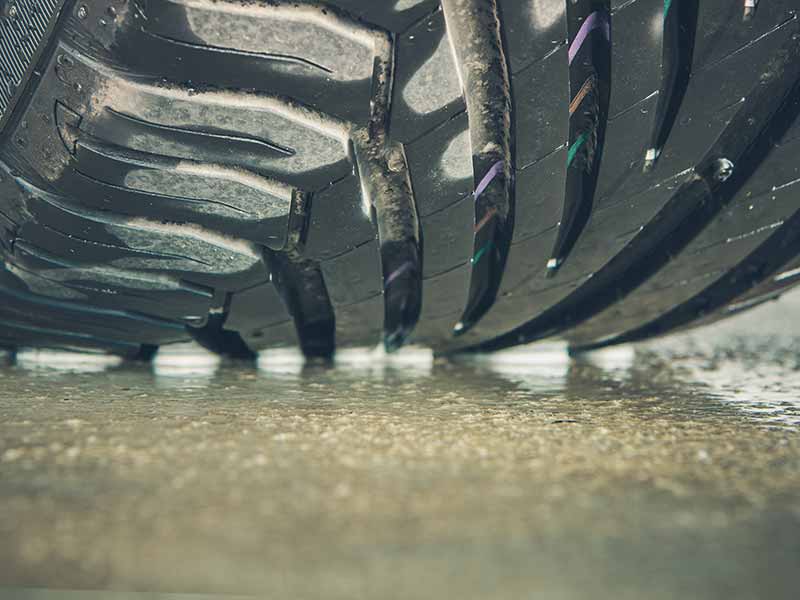It’s best to avoid hydroplaning, but there are times when you may still experience the a hydroplaning situation and it’s best to be prepared.
When your car hydroplanes you lose traction and control of your vehicle. Wet pavement can make the road surface slick, but hydroplaning can happen only when there is a more substantial amount of water on the road.
What To Do When Hydroplaning
- Remain Calm
- Remove Foot From Accelerator
- Press Brake Pedal Gently
- Avoid Steering Wheel Movement
- Steer Into The Skid
- Continue Driving After Regaining Control
Puddles and standing water are no match for even the most high quality tires if your speed is too great. Traction control and anti lock brakes can do little to help you maintain control of your vehicle once hydroplaning begins.
Let’s take a closer look.
Remain Calm
When you start hydroplaning, the natural reaction is to panic. It’s important that you try to fight that urge as much as possible and stay calm.
If you can remain calm, then you’ll more easily be able to navigate through the hydroplane without making things worse.
We’ve heard countless stories of people panicking when they start losing control, then subsequently slamming on the brake or gas pedal without thinking. As you’ll soon see, these are really bad ideas and will typically make things worse.
In the following video you can see the driver begin to hydroplane and start losing control of their car. At this point you can see the driver hit the brakes and the car begins to lose control, hits the jersey barrier, and then ricochets back into traffic and flips the truck in the middle lane.
We know that it’s easier said than done to stay calm while hydroplaning, but it’s essential. This accident may not have been avoidable once hydroplaning began, but it is possible if the driver remained calm and didn’t hit the brakes that they may have not have hit the barrier.
Remove Foot from Accelerator
Another common reaction is for people to slam on the pedal in their panic. You might not even notice that you’re doing it, since your body will be in a state of shock, and you will be tensing up.
The best thing to do is to get your foot away from the accelerator altogether. While hydroplaning, your tires might find patches of asphalt that they can grip to. If you’re accelerating while this happens, then you will propel yourself further into the hydroplane.
Due to the physics of hydroplaning, you might even spark a spin-out if you apply the accelerator at all.
Remove your foot from the gas pedal and either put it flat on the floor in front of you, or move it over to the brake pedal.
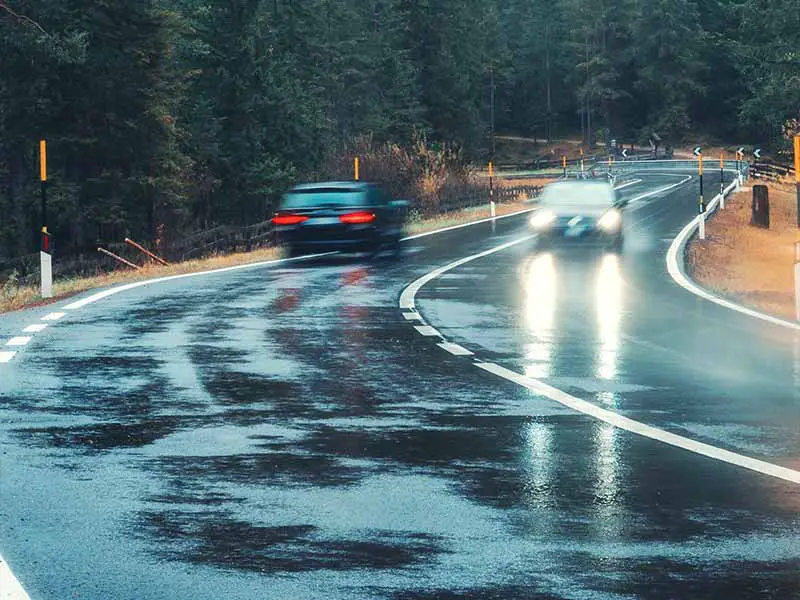
Press Brake Gently
Experts are split when it comes to applying the brakes, but we know that it can help your situation. The key is to very gently apply the brakes.
You should never, under any circumstance, slam on the brake or accelerator pedal while hydroplaning. The result will almost always be worse after doing so.
The previous video demonstrates this very well. The driver may have been much better off if they had not pressed the brake pedal at all.
If you apply a gentle, consistent pressure to the brake pedal and keep your foot there, it can help slow your car down slightly and regain traction.
If you have your foot all the way down on the brake pedal, you’ll find yourself in a similar situation that we were just explaining — when your car finds a bit of asphalt to stick to, the sudden braking will lurch your car and start spinning you.
However, you can forgo the brake altogether and keep your feet off of both pedals if you don’t trust your judgment when it comes to “gently” pressing the brake pedal. Again, too much brake is a bad thing here.
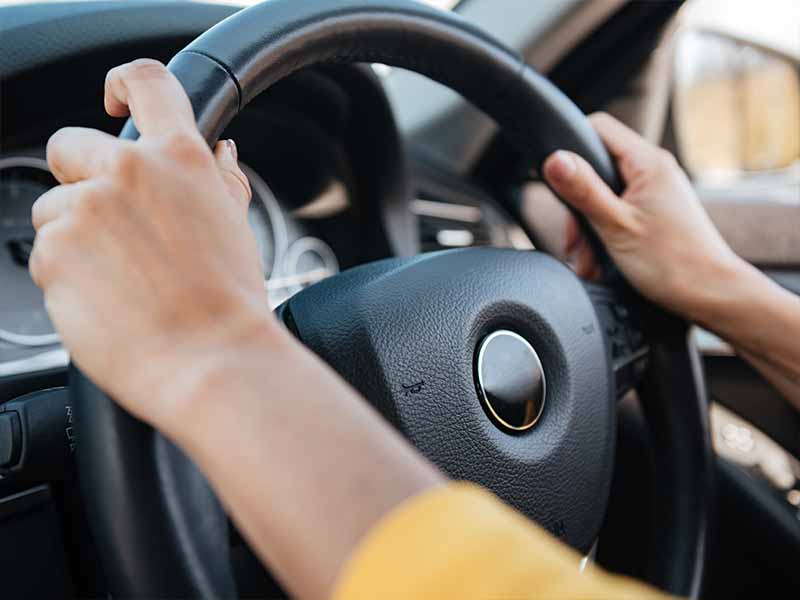
Avoid Steering Wheel Movement
If you’re hydroplaning and the car is staying straight, you’ll want to avoid moving the steering wheel at all. You should firmly grasp the wheel with both hands, and avoid moving your hands.
If you start to skid in one direction, then you’ll want to steer into the skid. This will help you better be able to recover control of your vehicle once it regains traction with the road surface.
Otherwise, keep your car pointing straight. As a warning, your steering wheel might feel like it’s vibrating and it might want to pull sharply in one direction. This happens when one tire suddenly gets grip or a deep puddle causing more resistance on one of your front tires.
You need to have a firm grasp your steering wheel to help maintain steering control and maintain traveling in a straight line to help prevent spinning out of control.
Steer Into the Skid
As we just mentioned, you should always be steering into the skid. What does that mean? Well, if you’re looking forward but your car is skidding slightly to the right, then you’ll want to move the steering wheel so that your wheels are pointing slightly to the right.
This goes against most people’s gut reaction. If your car skids to the right, you might want to steer to the left to compensate for this and overcome the skid. While that might work on dry roads, it makes things much worse on wet roads.
The problem is that your tires don’t have any grip. To maximize your chance of getting grip, you want them to be parallel with the direction of travel. By doing this, all the treads and channels and tread pattern are pointing in the same direction as your motion.
With everything in-line, you have a higher chance of maintaining control when you finally regain traction.
Continue Driving After Regaining Control
Even after you regain control, it’s not over. You will likely be tempted to come to a full stop and wipe the sweat from your brow.
However, there’s one big issue: other drivers. If you lose control and your car hydroplanes, the car behind you might be doing the exact same thing. If you’re stopped in the middle of the road, then the driver behind you can hydroplane into the back of your car.
They might not have any grip either and they’re going through the same thing you just escaped.
Instead, you should continue driving through your route. Be sure to lower your speed by a lot, since you were likely going too fast just before you began hydroplaning.
Causes Of Hydroplaning
It’s worth understanding what causes hydroplaning in the first place. Knowing the causes can help you prevent hydroplaning in the future — that way you’ll be prepared knowing what to do when you’re hydroplaning and what to avoid to prevent a hydroplaning situation.
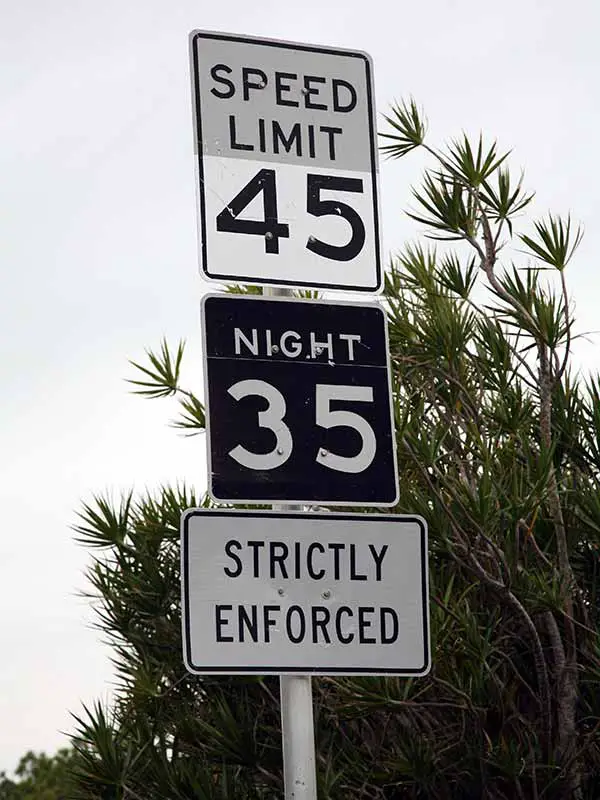
Vehicle Speed
The biggest factor that you have control over is your vehicle speed. If you’re driving faster, you have a significantly higher chance of hydroplaning.
As a result, it’s best to keep your speed low. If you’re going too fast, your car might start to give you warning signs. You’ll feel vibrations or short moments of losing control or “floating”. If you feel this, don’t slam on the brakes. Instead, allow your car to naturally slow down or gently apply the brakes.
When your car is going faster, it’s harder for water to travel through your tires’ channels and get pushed away from your tires. Instead, water will start to pool up in front of your tires. Once this starts, hydroplaning is much more likely to happen.
Avoid using cruise control. Cruise control can increase the risk of hydroplaning, removes some control of your car or truck from you, and can cause brief confusion and panic in a hydroplaning situation.
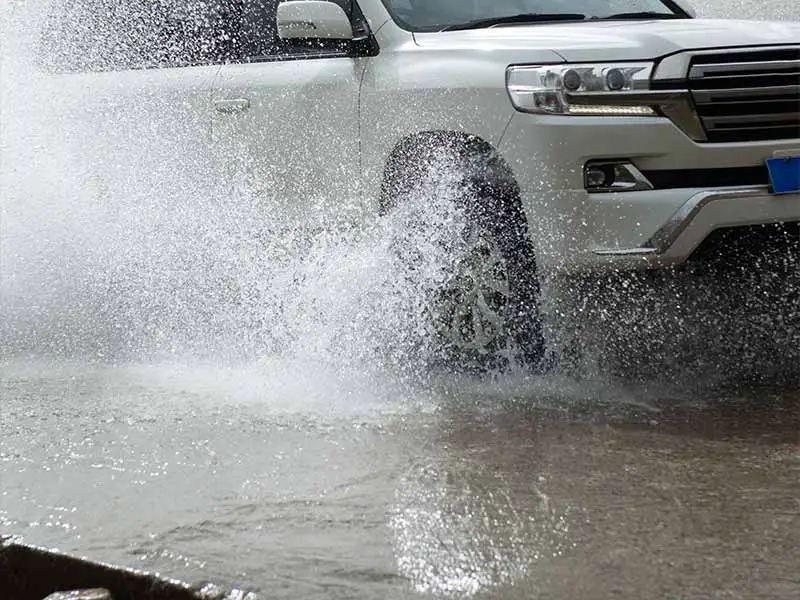
Water Depth
Another factor is how deep the water is. If it’s a light layer, then your tires can probably trudge through and direct the water away from your car. With deeper standing water, your tires have to work much harder. Once it reaches a certain depth, the water overwhelms your tires and you can start hydroplaning.
With deep enough standing water, you can run into a lot of other mechanical issues. It’s best to avoid standing water altogether when you’re driving.
Tread Depth
Your tire tread depth plays a huge role in how much your tires have on a wet road. If your tire tread depth is under 4/32” deep, then you should consider changing your tires. If you low tread depth you’ll need to drive much more slowly when driving in the rain to help avoid hydroplaning.
Deeper tread grooves mean more traction in wet conditions, more ability to channel water away, and shorter stopping distances on wet roads. Worn tires have much less ability to resist hydroplaning and greatly extend stopping distances in wet conditions.
The minimum legal tread depth in most states is 2/32″. While this is usually the legal minimum, most tire professionals will highly recommend replacing your tires once they reach 4/32″ due to the much greater hydroplaning resistance and shorter stopping distances in wet weather.
Resources
Below are some links you may find helpful when learning about tires
- What to do when hydroplaning – Nationwide
- Hydroplaning explained: 9 safety tips to keep your vehicle under control – Driving Tests
Final Thoughts
If your car hydroplanes when driving in the rain, be sure to remain calm, allow it to slow down gently, and avoid sudden steering movements.
Be sure to continue driving once you regain control of your car to move clear of any vehicles that may be behind you that might also hydroplane due to the same conditions.
Good luck and happy motoring.
